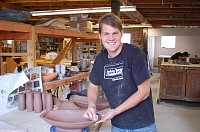BIOGRAPHY

Originally from Minnesota, Tom received a BA in Visual Art and a BS in Biology with a minor in Chemistry from Bemidji State University. He was a summer resident and a long-term resident at the Archie Bray Foundation. In the fall of 2015 Tom began a 3-year residency with his wife Maggie Jaszczak at the Penland School of Craft. In 2018 Tom and Maggie put down permanent roots in Shafer, MN where they live in a farmhouse and work in a barn style studio. Tom has received several awards and honors including, a Jerome Projects Grant, ECRAC Essential Artist Award, Emerging Artist Award through NCECA, as well as Ceramics Monthly, Lincoln and Lil Street Fellowships through the Archie Bray Foundation and in the summer of 2014, Tom was an Honored Maker at the Maker’s Faire at the White House in Washington D.C under the Obama presidency. Tom’s current body of work are a range of pots made of red earthenware that explore minimalism and are finished with a surface solution that uses a soda ash atmosphere and fired to cone 2.
Artist Statement: “My work is rooted in the wonderful studio pottery tradition of Minnesota. I grew up in Minnesota, went to university in Minnesota, and the pots I handled and admired in those formative years were those of local Minnesota potters. The work of many of these potters had a way of showing the materiality of clay, which was attractive to me. Often, the pots had an inventiveness in form as well – as they were relatively minimal, the forms had to be ‘just right’. And so, my first interest in clay was in developing my own inventiveness in form. I am constantly seeking a balanced proportion and a gentle angularity to accent the changes in direction of rims, feet, and body of my pots. With its planes and clean lines, my work has moments of design and craftmanship, while retaining strong moments of the hand and process – my own personal version of that materiality which I have so admired. My pots are minimal but show depth and richness through this materiality – first, with the scrapes, small pits, and ruggedness of the red brick-like clay I use; then with a layer of poured slip, which adds fluidity, and a rich depth in surface picked up both from the iron clay underneath, and the spontaneity of the atmospheric soda firing in which I fire my work. Finally, a bright, flat, decorative element, painted with underglaze, sits in the foreground, and often gives the pot a sense of orientation. This cumulative journey of the pot tells a story, and the story brings the user into the moment of making and firing. Slips, trimming lines, finger marks, edges, wad marks, drips, scratches, and shadows capture a moment in time and tell more of the story.”
